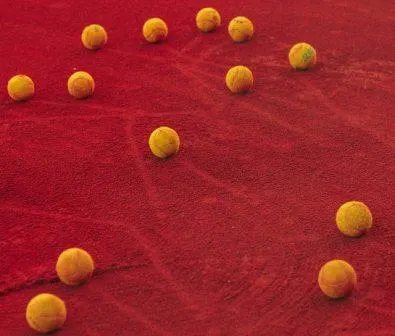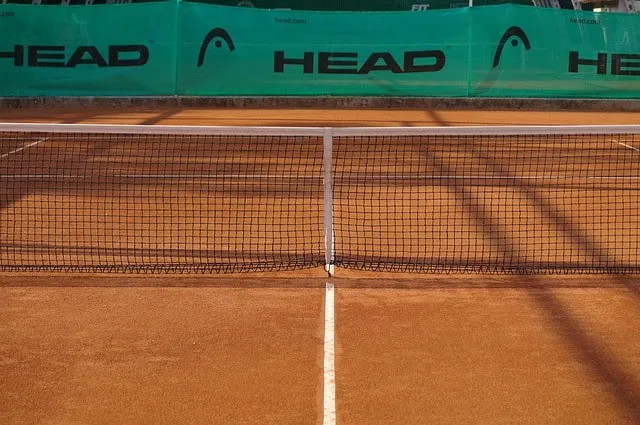
With the French Open 2020 in full swing, albeit a lot later in the year than normal, it’s interesting to see how some top players struggle on the surface, where as others seem to thrive.
Anyone can see it plays very differently to hard courts and on the grass. But is it harder to play tennis on clay? In this article, let’s answer this question, plus look at how you should play on this surface.
Is Clay Harder?
To answer the question directly, clay isn’t harder to play on, but it depends on your strengths and weaknesses as a player. Rallies are longer, so you need to be extremely fit, the serve isn’t as much of a weapon, so being a good returner is a big plus. Also, if you hit with heavy topspin, that’s also a big advantage.
Finally, it depends on your upbringing as a tennis player. If you’ve grown up playing on clay a lot, which is common in some of the Mediterranean countries like Spain, you’re going to find it easier than someone who trains regularly on hard courts.
What’s the most difficult surface to play on?
This is a subjective question, and the answer will vary from player to player. Basically, the most difficult surface will probably be the one you play on the least and the one which doesn’t suit your game very well.
If you have a good serve and you like to use the serve and volley as a tactic, then hard courts and grass will be better for your game. If you enjoy long rallies from the baseline, are hit with plenty of topspin, and have plenty of stamina and endurance, then clay will be a good surface for you.
Interestingly, over at the Tennis Warehouse, a poll among the forum members believes the French Open is the hardest to win due to its grueling nature and the demands it puts on the body in terms of fitness and endurance.
However, interestingly another poll shows that players believe playing on grass is a lot tougher than clay due to the low, sometimes irregular, bounce of the ball, as well as how it skids through the court.
Is clay the slowest tennis surface?
Yes, clay is the slowest surface. When the tennis ball hits the ground, it slows quite a bit, giving players a lot more time to hit their shots. It’s a lot harder to hit a clear winner on this surface, so you have to play intelligently to open up the court to finish off the point.
How do you play tennis on a clay court?
Playing on clay is a very different experience compared to grass and hard court. Here are 5 tips for becoming a better tennis player on this surface:
Play with more patience
On clay, you’re not going to blast your way to victory and hit outright winners all the time. The ball slows up too much which gives your opponent more time to return your shots. Playing too aggressively will likely result in hitting more unforced errors. Therefore, you need to play with more patience and pick the right moment to attack.
Hit behind your opponent
The clay court surface is often slippery to play on, which means it can be difficult to change direction quickly. A great tactic is to hit behind your opponent when they’re trying to recover towards the centre of the court.
Learn how to slide
When you watch Djokovic or Nadal playing on clay, you’ll often see some incredible slides during a rally. Although you don’t have to slide on this surface, it helps keep your balance when you slow your momentum during a shot and it allows you to recover quicker.
Learn all the shots
Playing well on clay is more about placement than power. Therefore try to master all your shots; the slice, drop shot and top-spin groundstrokes. Keep your opponent guessing by mixing things up.
Build up your stamina
You need to be prepared for long rallies playing on clay, which can be particularly gruelling in a best of 3-set match. Make sure you do some extensive interval training and some long distance running to build your endurance.

Are clay courts better for your knees?
Yes. Clay courts are the best surface to play on as it puts less stress on your knees and back. If you play tennis regularly and you are an older player, you should definitely consider playing on clay more than grass and hard court surfaces.
Interestingly most people who choose to play on clay do so because they think the surface is soft. However, you only need to see how high the ball kicks up on clay to know this isn’t exactly true. In fact, various studies have shown that injuries are more likely due to the high friction on surfaces like grass and hard courts.
On clay, you can slide into your shots more as the friction is less, which means it’s less damaging to your body.
How to slide on a clay tennis court?
The guys at Top Tennis Training have a great video showing how to slide on a clay court.
There are various ways you can slide, but the key is lunge as you lean into the shot staying low throughout.
- For right handers, you can slide with your right foot forward, which is ideal of you are attacking with your forehand.
- You can slide on the side of the foot for a forehand or backhand ground stroke if your opponent has got you on the run in a side-to-side movement.
- You can slide and then hit your shot. This is common if you have more time to execute your shot. It also gives you the most amount of power generated through the legs.
- You can slide as you hit your shot, which you can do if you have a bit less time, particularly on a wide ball.
- You can hit your shot and then slide, which could happen if your opponent has got you on the run. If possible, you should avoid this as the slide afterwards can pull you further out of position and leave your opponent with more of an open court to hit a winner.
Best clay court slides
Nadal and Djokovic are particularly well-known for their clay court slides during a rally. Here are 10 amazing clay court slides featuring these two players, as well as some others.
Why do tennis balls bounce higher on clay?
If we look at Roland Garros, the main reason why the ball bounces higher is to do with what’s underneath the clay surface. The actual top layer of clay is only a couple of millimeters deep, but underneath there is a thicker layer of limestone, which is very hard.
Most people think clay is softer, but this deeper layer of limestone actually makes the surface harder than grass or hard courts, which results in tennis balls bouncing higher.
What’s the difference between hard court and clay court tennis balls?
Tennis ball manufacturers have different ball types for different surfaces, and they are usually labelled as regular-duty or extra-duty.
Extra-duty tennis balls are slightly thicker, a bit fluffier and don’t wear out quite as quickly. These are ideal for hard-courts.
Regular-duty tennis balls are great for clay courts as the thinner felt doesn’t pick up as much of the clay material during a rally, which stops it becoming too heavy.

Who is the best tennis player on clay?
Rafael Nadal
You’d have to be living under a rock not to realise that Rafael Nadal is by the far the most successful tennis player on clay. He has won an astonishing 12 French Open titles in his career (as of 2020), and 59 titles on the clay in total. Somehow I don’t think he’s finished yet as he continues to chase Roger Federer’s leading overall total of 20 Grand Slams.
Aside from Rafa, there have been several other tennis players who have certainly dominated on the clay court surface at some time or another.
Bjorn Borg
In his short career, Bjorn Borg won 6 titles at the French Open and 30 titles in total playing on clay. It’s easy to forget that he retired at a young age, only 26, so he could have won so much more.
Ivan Lendl
Ivan Lendl deserves a mention as a clay court specialist. He reached the French Open final 5 times, and won it 3 times. In total he won 28 titles playing on clay.
Why is Rafael Nadal so good on clay?
Not to take anything away from the ‘King of Clay’, but the clay surface is a big factor in helping Rafael achieve his success. The surface is very bouncy, and with Rafa’s heavy topspin the ball kicks up and pins his opponents at the back of the court. Also, the court surface is the slowest, which gives him time to load up his powerful forehand and hit a winner.
Furthermore, big servers don’t tend to do well on clay. It gives good returners, like Rafa, more time to get the ball back and put the opponent under pressure. He has won a staggering 43% of all games on clay when he’s been the receiver, an almost 1 in 2 success rate, which is amazing when you consider the server is supposed to have a big advantage at the pro level. Furthermore, if you’re serving against Rafa, you’d better get you first serve in, because he’s won 57% of all points when he’s faced a second serve.
It’s not just his raw power which has helped Rafa become so dominant on clay. He can construct points brilliantly, by throwing in the occasional drop shot, which is even more effective when his opponent is often pinned back behind the baseline
FAQs
Can you wear clay shoes on a hard court?
Yes, but it’s not advisable and the shoes won’t last as long. Firstly, the grip will wear out faster as the hard court surface rubs against the sole of the shoe. Also, you won’t get the same protection and cushioning as you do from hard court tennis shoes. In fact, you’re more likely to pick up knee, hip and other leg injuries if you regularly play on a hard court with clay court shoes.
Do clay court shoes make a difference?
Clay court shoes have a very different pattern on the sole of the shoe compared to other tennis shoes. They feature a herringbone pattern which really helps you to slide on the clay surface for side-to-side and forward and backwards movement. Playing with the right footwear will certainly help your game on the clay court surface.
Do clay courts ruin your shoes?
No, playing on clay won’t wear out shoes as much as hard courts or playing on grass. Bits of clay will get stuck to the sole of the shoes, but it usually comes off easily with a tap or two from your racket.


